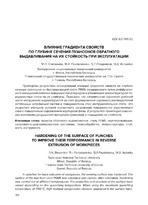| dc.contributor.author | Степанкин, И. Н. | ru |
| dc.contributor.author | Пантелеенко, Ф. И. | ru |
| dc.contributor.author | Поздняков, Е. П. | ru |
| dc.contributor.author | Астрейко, А. В. | ru |
| dc.coverage.spatial | Минск | ru |
| dc.date.accessioned | 2019-06-20T10:51:35Z | |
| dc.date.available | 2019-06-20T10:51:35Z | |
| dc.date.issued | 2018 | |
| dc.identifier.citation | Влияние градиента свойств по глубине сечения пуансонов обратного выдавливания на их стойкость при эксплуатации = Hardening of the surface of punches to improve their performance in reverse extrusion of workpieces / И. Н. Степанкин [и др.] // Современные методы и технологии создания и обработки материалов : материалы XIII Международной научно-технической конференции, (Минск, 12-14 сентября 2018 г.). – Минск , 2018. – С. 194-202. | ru |
| dc.identifier.uri | https://rep.bntu.by/handle/data/53588 | |
| dc.description.abstract | Приведены результаты исследований влияния градиента свойств по глубине сечения пуансонов из быстрорежущей стали Р6М5, создаваемого путем диффузионного насыщения рабочих поверхностей углеродом и управления микроструктурой поверхностных слоев на их стойкость. Показано, что напряженное состояние рабочей части инструмента корректируется за счет формирования заданного распределения остаточных напряжений сжатия в поверхностном слое инструментальной стали. Это позволяет улучшить условия контактного нагружения поверхностно упрочненного слоя с повышенным содержанием карбидной фазы. В результате происходит изменение механизма разрушения материала пуансонов и повышение их стойкости. | ru |
| dc.language.iso | ru | ru |
| dc.title | Влияние градиента свойств по глубине сечения пуансонов обратного выдавливания на их стойкость при эксплуатации | ru |
| dc.title.alternative | Hardening of the surface of punches to improve their performance in reverse extrusion of workpieces | en |
| dc.type | Working Paper | ru |
| local.description.annotation | In punches for back extrusion of workpieces, the working surface was hardened. The surface of the tool from steel P6M5 was saturated with carbon. After saturation, hardening was carried out at different temperatures. The properties and structure of the surface layer varied depending on the quenching temperature. When using the maximum quenching temperature of 1150 °C, high residual compressive stresses appeared in the surface layer. The stress state of the instrument was modeled taking into account the magnitude of the residual stresses. When testing the punches, it was shown that the greatest efficiency was achieved when quenching from a temperature of 1150 °C. The working layer of the tool has an optimal structure, hardness and stress state. | en |

